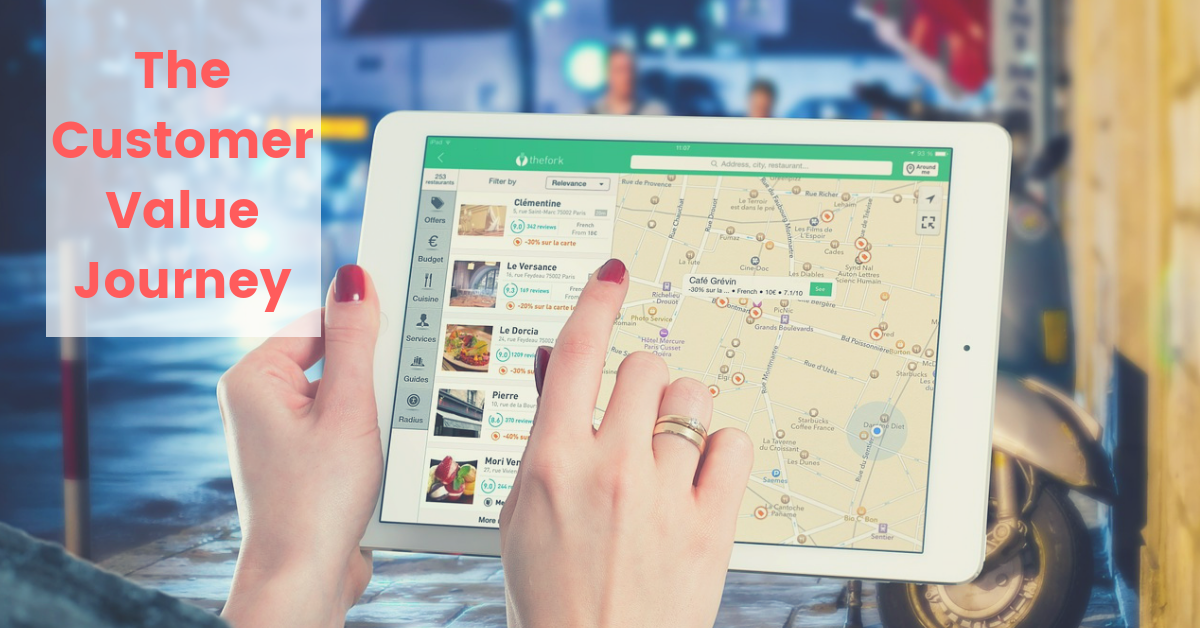This Journey is the process every prospect goes through to become a new customer. It’s how strangers become buyers and, eventually, raving fans of your business.
Let’s walk through the 8-step process of crafting your digital marketing strategy:
Step 1: Awareness
Before someone can buy from you, they have to realize you exist—right?
This step is pretty self-explanatory: It’s where the person becomes aware of you. After all, nobody is born knowing who Apple or Amazon are. At some point they have to become aware of these companies if they are to become a customer.
Examples of Marketing that Generates Awareness
There are any number of ways a prospect could become aware of your company, products, and services. Here are three possible scenarios:
- A father of two sees an advertisement for a new children’s summer camp on Facebook.
- An office manager searches Google to find a new coffee supplier.
- A college student watches an Instagram video of her friend raving about a new brand of noise cancelling headphones.
Step 2: Engagement
Your prospect is now aware of you—they know who you are—but you’re still in the early stages of a relationship with them. They don’t yet know you, like you, or trust you.
Engagement, is where you start conversing with your prospects. You engage them through some form of content that provides entertainment, information, or both. Engagement is something that must continue throughout the Customer Journey. It’s not something you do once and move on.
To improve engagement in your company, the digital marketing tactics you need to master or hire include:
- Content Marketing
- Social Media Marketing
- Email Marketing
Step 3: Subscribe
At this point, your prospect knows who you are and has engaged with you in some way or another.
However, if you failed to get that person’s contact information, odds are high you’ll never hear from them again.
People in this age are inundated with marketing and content, creating a scarcity of attention. Just because someone reads one of your blog posts today does NOT mean they’ll remember to revisit your site in the future. Instead, you need to get that person to progress to Step 3 in the Value Journey, which is to subscribe.
In each case, the prospect fills out a form, provides their contact information, and is sent information about how to access the offer.
To get more subscriptions for your company, the digital marketing tactics you need to master or hire include:
- Landing Page
- Content Marketing
- Email Marketing
- Google Display Network
- Social Media Marketing
Step 4: Convert
If the subscribers you gain in Step 3 of the journey remain engaged, some of them will be ready to increase their level of commitment. They like the information you share and have begun to trust you, so they’re ready to invest in one of two ways: either with time or money.
At this stage, to ask for a significant investment in a complex product or service would be asking too much, too soon. In fact, it’s too early even to concern yourself with profitability. The Convert stage of the Customer Value Journey is about acquiring buyers or ramping up the commitment level of the leads you already have. It is NOT about profitability.
The goal is to acquire a new customer. Profits come later.
Remember, one of the costliest (in time, money, resources) marketing activities your business will undertake is the acquisition of customers. The good news is that once you’ve acquired them, you don’t need to pay to acquire them again.
Getting that initial conversion was the hard part. Now they can build the customer relationship to create profits down the road.
To improve conversions in your company, the digital marketing tactics you need to master or hire include:
- Search Engine Marketing
- Content Marketing
- Email Marketing
- Social Media Marketing
* Wondering how to keep your businesses relevant? To achieve this you will need to keep up with the latest trends and here’s what hot in 2019: Top 8 Digital Marketing Trends in 2019. Also check our post: 5 SEO trends that will matter most in 2019.
Step 5: Excite
At this point, your new customer has had a transaction with you. A small transaction, sure, but a transaction nonetheless.
Your job now is to make sure the transaction is a good one, that the excitement of the purchase develops into good will and trust. This stage is all about ensuring that your marketing is giving your customer opportunity to get value from doing business with you—and to enjoy that value right away.
Step 6: Ascend
At this stage of the Value Journey, you’ve sunk time, money, and resources into acquiring leads and customers and making sure they get value from doing business with you.
Always remember that it costs more to acquire a new customer than to sell to an existing one. That first sales isn’t about profits. It’s about converting a prospect to a customer, so you can begin a long (and profitable) customer relationship.
Step7: Advocate
You now have a happy customer who has made several profitable purchases from you. The next stage in the Value Journey is to create marketing that encourages your most loyal customers to advocate for your business.
An advocate is someone who speaks positively about your brand. An advocate is what you might call a “passive promoter.” They won’t necessarily promote your business in an active way, but when asked about you, they will respond favourably.
Step 8: Promote
Promoters differ from advocates in that they are actively seeking to spread the word about your brands, products, and services.
This puts your message in front of a new audience, the fans, followers, and friends of the promoter. And because this new audience is hearing about you from a trusted source who they already know, they’re much more likely to become customers themselves.
Examples of Marketing That Generates Promoters
Intentionally creating more promoters is important because it creates an army of paid or unpaid salespeople spreading the word about what you sell.
A good example of this is Dropbox. When it was just starting out as a new company in a new industry, they realized discoverability would be key to their success. So they initiated a referral program that gave its users a strong incentive to promote the service to others.
Credits: Digital Marketer


